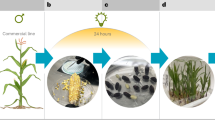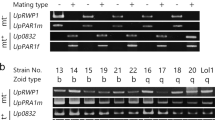Abstract
THE haploid chromosome number of Encephalartos barteri, observed at the first division of the microspore nucleus, is 9. The chromosomes are large; the largest is about 20µ long, the smallest about 10µ long. One of the longest chromosomes has a trabant (Fig. 1). The haploid number of 9 chromosomes has already been found in the six other species of the same genus which have been examined, and in species of Zamia, Bowenia, Dioon and Macrozamia 1.
This is a preview of subscription content, access via your institution
Access options
Subscribe to this journal
Receive 51 print issues and online access
$199.00 per year
only $3.90 per issue
Buy this article
- Purchase on Springer Link
- Instant access to full article PDF
Prices may be subject to local taxes which are calculated during checkout
Similar content being viewed by others
References
Darlington, C. D., and Wylie, A. P., “Chromosome Atlas of Flowering Plants” (London, 1955).
Author information
Authors and Affiliations
Rights and permissions
About this article
Cite this article
BERRIE, G. Mitosis in the Microspore of Encephalartos barteri Carruth.. Nature 183, 834–835 (1959). https://doi.org/10.1038/183834a0
Issue Date:
DOI: https://doi.org/10.1038/183834a0
Comments
By submitting a comment you agree to abide by our Terms and Community Guidelines. If you find something abusive or that does not comply with our terms or guidelines please flag it as inappropriate.



